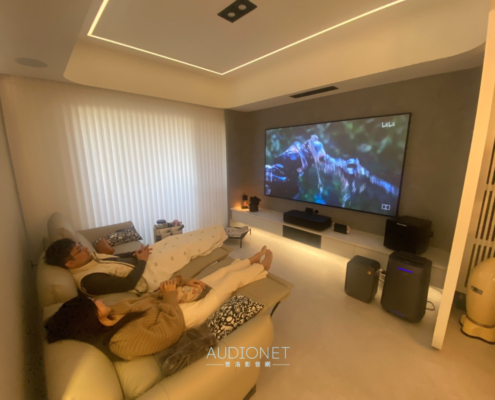[器評] 瑞典PRIMARE A35.8 英國AV Forums推薦!Prime級別的八聲道後級

Primare A35.8 的外型毫不起眼。它只是一個帶有開關的黑盒子,這是一個好的開始。但這是一台音質絕佳的擴大機。電影和音樂充滿細膩的細節、絕佳的影像和景深。更重要的是,對於 D 類設計而言,音樂音源幾乎是實實在在的,具有令人愉悅的類比質感。這一切都令人驚訝。身為消費者,您必須準備好花大錢購買最好的擴大機,以打造專屬的家庭劇院室。但也請記住,這些元件很可能會在您的影音室中找到最長時間的安身之所。如果您正處於購買八聲道(或十六聲道)無窮功率的決策階段,我們建議您不要忽略 Primare A35.8。
優點
- 令人驚豔的音訊細節
- 宏偉的音場
- 多樣化的橋接能力
- 優雅、低調的構造
- 體積小巧
Cons
- 自信的音場可能不是每個人都喜歡
他是誰? Primare A35.8
對於那些為專用電影院尋找設備的人來說,Primare 通常不是一個家喻戶曉的名字。但這家由 Bo Christensen 創立的瑞典公司自 1985 年起便已存在。它在影音界的知名度相對較低,這是因為它最近才重新回到影音界。
該公司曾因其大膽的工業級雙聲道元件設計(如 1986 年的 928 系列和 1992 年的 200 系列)而贏得讚譽。到了九十年代初,Primare 開始涉足 AV,推出了一些處理器和整合放大器。然而時至今日,完整的產品清單已包括各種網路播放器、CD 播放器、唱頭前級放大器、前級與功率放大器,以及最新的 AV 元件。

我們聽說,瑞典語中有一個詞可以概括整個系列的特點,那就是「logom」(讀作「loah-goam」)。字面上的意思是「不要太多,也不要太少」。這裡的意思是產品的任何部分都不應不必要地引起別人的注意。體驗應該在音樂詮釋本身,而技術應該消失。
……產品的任何部分都不應不必要地引起別人的注意
Primare A35.8 於去年推出。這是一款適用於多聲道應用的八聲道功率放大器,顯然是為了在家庭影院中提供最佳效能而設計。雖然該公司沒有在屋頂上大肆宣傳,但這款擴大機採用 D 類架構,並擁有 1,500 瓦的最大輸出功率。鑑於大多數的多聲道功率放大器都會選擇奇數聲道,以容納家庭劇院的中央喇叭,因此八聲道是一個有趣的選擇。不過這也是有原因的,我們稍後會討論。
Design
A35.8 絕對符合「logom」生活模式。華麗的黑色拉絲精鋼面板僅飾有 Primare 的名稱和標誌,後者雕刻在表面並圍繞著開關開關。不過,35.8 也有鈦金屬面板可供選擇。面板本身看起來與機身分離,因為周圍有一圈凹槽,增加了設計的精緻感。

A35.8 也配備鈦金屬面板
Primare 的寬度為 43 公分,非常適合在 IT 或 AV 機架上使用。14.5 公分的高度和僅 40 公分的深度,在標準的架子後面應該有足夠的空間來管理您所有的線材。採用 D 類設計的擴大機有一個明顯的優點,就是可以將更多的電路和散熱模組裝入一個機箱內,而且不需要像 AB 類擴大機那樣笨重的環型變壓器。即使是 15 公斤的重量,與採用競爭技術的型號相比也相當容易處理。機箱本身是由霧面黑色紋理鋼材所組成,幾乎整個上表面都有方形散熱格柵。

Primare A35.8 後接頭
後板整齊地排列著平衡 XLR 和 RCA 輸入、橋接開關和揚聲器連接。這些包覆塑膠的外殼是為了讓導入裸銅端子的工作變得更容易,但這一點還沒有定論。
連線與控制
Primare 包裝內附有一條 C20 IEC 線、紅外線/觸發線和 AC 極性筆連電池(用於檢查 AC 插頭方向)。有兩個 3.5mm 12V 觸發埠:一個輸入、一個輸出。您還可以獲得一個 RS232 外接式系統控制埠。在待機模式下,前板上的開關開關上方有一個三角形的白色 LED 小燈微亮。開機時,當內部電路穩定時,同樣的燈會閃爍幾下,然後轉為穩定的白色。當然,您也可以透過隨附的觸發線喚醒 Primare。

A35.8 連接提供大量彈性

A35.8 連接提供大量彈性
背面有 XLR 或 RCA 的翻轉開關。還有一個三點式翻轉開關,可允許雙聲道、橋接或橋接 +6 dB 模式。每個通道都可以連接阻抗負載在 2 到 8 ohms 之間的揚聲器。
特點與規格
由於上述的開關,35.8 有多種設定配置選項。為了達到極致的效能,本產品可當作 2.0 雙功放系統使用,將所有輸入對橋接,提供 4 x 375 瓦 (或每對 750 瓦) 至 8 歐姆的峰值功率。或者,您也可以選擇運行 5.1 系統,將橋接的輸入對分別連接左、右和中央,並將兩個未橋接的輸出連接至一對環繞音箱。如此一來,佈局的選擇就更多了。有些人會選擇兩台 Primares 為 15 聲道提供電源,例如 9.x.6 配置,只橋接中央聲道。35.8 的總輸出功率為 8 x 150 瓦(8 歐姆)或 8 x 300 瓦(4 歐姆)。
配置選項
Primare 使用四對 Hypex Ncore NC500 D 類擴大器模組。Primare 表示,這種電路佈局提供了「最直接的電力傳輸與最平均的電力分配」,從電源供應器到埋在散熱片中的模組。反過來,這應該可以隔離電源雜訊。此架構還可確保輸入和輸出階段與放大器模組本身可能產生的任何雜訊隔離。

35.8 配備該公司目前生產的最大電源供應器。根據製造商的說法,雙電纜以最短的路徑從電源供應器連接至每對放大器模組。如果偵測到削波情況,一系列內部紅色 LED 燈會閃爍。透過放大器機箱頂部的柵欄,可以看到這些燈。
設定與操作
每當有新的硬體插入機架時,就必須重新執行 Lyngdorf 的 RoomPerfect 校正程序。這個程序必須針對兩個不同的配置執行兩次。最合理的做法似乎是先讓 Primare 使用標準立體聲輸出為 LCR 和兩個環繞供電。第二個設定是將三個 Primare 輸出橋接到 LCR。請注意,這裡使用的揚聲器是 M&K S150,負載為 4 歐姆,每個衛星的功率都相當大。
性能表現
由於運送給我們的 35.8 已經完成了一些評測回合,我懷疑擴音器不需要太長的磨合期。儘管如此,我們的一貫政策是讓擴音器熱身至少一、兩小時,讓電路和接頭磨合。
在第一個非橋接配置中,我們透過 Lyngdorf 開啟 Spotify,聆聽 Ron Goodwin 的「Miss Marple’s Theme」。小提琴在混音中時而起舞,時而飛揚起來,沒有一絲搔癢或崩裂的感覺。
影像和景深如此精確,讓您感覺自己可以走進錄音室或演出場地。
在我們播放的每首音樂中,音場都是寬闊而開放的,節奏部分的表現令人驚訝地感覺像模像樣。Kick drums 和 Snares 在搖滾和爵士樂選曲中的攻擊力和衝擊力栩栩如生。每個音源的定時都非常精準,內在的瞬間效果為音樂的每一小节增添了畫龍點睛的效果。與此同時,音質平順且沒有尖銳感,這對於以 D 類為基礎的架構來說也許是個驚喜。影像與景深如此精準,讓您感覺可以走進錄音室或演出場地。

轉換至 5.1 配置,Paul McCartney 與 Wings 演繹的《Live and Let Die》(1972 年,藍光版)的顫動和弦充斥著整個房間,渾厚的力量在揚聲器之間顯得天衣無縫。在《西區故事》(West Side Story,2022 年,4K UHD Blu-ray)中的「在健身房跳舞」一節中,清晰的大樂隊迴響之間的對話既悠揚又有層次感。
……35.8的音場可說是充滿自信,甚至咄咄逼人。
現在,值得指出的是,35.8 的音場可被形容為強勢甚至咄咄逼人。雙聲道發燒友可能會對此感到詫異,並認為這是 D 類擴音機拓樸結構的可預見特性。但我現在可以告訴您,我願意用我目前的參考 AB 類功率放大器(雖然已經老化)來換取這些特質,尤其是用於電影娛樂。Primare 的整體多聲道表現令人印象深刻。
我現在可以告訴您,我會用我目前的參考 AB 類功率放大器(雖然已經老化)來換取這些特質
在設定了三聲道橋接式 LCR 佈局後,我試聽了一些 CD 和更多的串流內容。一如所料,現在的音樂音源更有厚重感和權威感。Revolutionary Road》(2009 年,CD)「End Title」中的鋼琴聲很容易讓我置身其中。琴槌敲擊琴弦的聲音及其鮮明的和聲,讓錄音室的頹聲真實呈現。令人愉悅。
Video Review
結論
Primare A35.8 八通道功率放大器評論
- 我該買一台嗎?
以 D 類為基礎的功率擴大機在歷史上並不總是讓這位評論員感到驚訝。恕不具名,在某些品牌和產品類別上,我們曾有過不太光彩的經驗。我特別想起兩款產品,聽起來非常刺耳和疲憊,幾乎無法聆聽。但 D 類技術的改進正以迅雷不及掩耳之勢進行著。我從來沒有想過在電影院裡取代我的 AB 產品。
… Primare 的多聲道表現令人印象深刻
Primare 35.8 是一款絕對出色的多聲道功率放大器。是的,這是關於細節的層次、巨大的動態、鐳射般的影像。此外,它還擁有誘人而優雅的精巧設計。老實說,這款產品會讓人瞠目結舌。如果您正在打造夢想中的電影院,我們強烈建議您將 Primare 35.8 列入您的候選名單。
- 我有哪些替代方案?
與其花錢購買兩部 8 聲道擴大機,何不看看我們對 Storm Audio PA 16 Mk2 的評測?這款 16 聲道 D 級擴大機提供的功率足以構成一整套身歷其境的音訊系統,搭配 Lyngdorf 或 Trinnov 處理器更是不二之選。它的價格是 Primare 的兩倍多一點,所以 PA 16 應該是您的潛在客戶名單。它也贏得了我們 2020 年「同級最佳」的殊榮。
我們也檢查了 NAD M28 7 聲道金屬板,它可分別為每個 8 歐姆的揚聲器提供 200 瓦的功率,或為每個 4 歐姆的揚聲器提供 340 瓦的功率。M28 採用 NAD 的混合數位技術,並結合 Purifi 的 Eigentakt 擴大機架構,能夠提供「強大的動力」。這款揚聲器的重量僅不到 1 公斤,是「令人驚豔的工業設計」。
得分

技術服務諮詢
M&K Sound台灣總代理 愷銳音響 台北總公司
地址:台北市信義區信義路六段22號2樓 | 電話:02-2726-1286
台中展示中心
地址:台中市西屯區台灣大道三段709號 | 電話:04-2258-1918
















